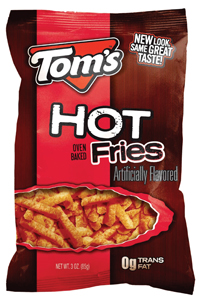Lance Plans Demand with Confidence
 Lance Inc., an $830-million company, manufactures and markets snack foods under the Lance, Cape Cod and Tom's brand names throughout much of the United States and other parts of North America.
Lance Inc., an $830-million company, manufactures and markets snack foods under the Lance, Cape Cod and Tom's brand names throughout much of the United States and other parts of North America. Improvements in Demand
About 50 percent of Lance's products are distributed through a direct store delivery (DSD) structure of approximately 1,400 sales routes in 25 states. The snack products are also distributed through an independent distributor network and direct shipments to retail customer locations.
In late 2005, Lance acquired Tom's Foods, bringing new complexity with many additional different forecasting avenues to the DSD structure. This acquisition exposed several operational opportunities for improvement, and made increased customer service levels a focus.
For example, demand for Lance's three business components -- branded, private brands and contract manufacturing -- was managed differently and at different levels. The company had no effective method for achieving a consensus forecast.
Greg Wolljung, vice president of service and distribution, Lance, says, "We had five different demand processes operating at one time; we hoped they would come together with one number, but frequently they did not."
Additionally, Lance's product promotions drive significant variability in demand patterns; it is costly if a forecast is inaccurate when predicting promotional lifts, seasonal volume changes, and new product introductions or phase-outs.
In addition, the snack product industry has several unique supply chain challenges. Lance's products have a shelf life of 80 to 120 days, and it is standard for the items to have at least two-thirds of that life left when the end consumer purchases it.
Lance wanted to become a "push" rather than "pull" demand-driven company and needed a solution that would help build inventory at strategic points in its supply chain. A critical element to this plan was the formalization of an executive sales and operations planning (S&OP) process.
Working with One Plan
Lance implemented Logility Voyager Solutions to help ensure visibility across the enterprise and put a monthly demand planning process in place with three key performance indicators in mind: forecast accuracy, days on hand and implementation of the executive S&OP process. More accurate forecasts were expected to help meet the company's goals of reducing working capital, improving operational efficiencies, increasing freshness at the shelf and optimizing inventory.
Using the new solutions, Lance's forecast accuracy increased from 50 percent to 70 percent. Better visibility has led to a significant reduction in days on hand, a critical measurement in the perishable food market.
"I feel certain that we will continue to bring that measure down even further with the visibility we have from Logility Voyager Solutions," says Wolljung.
A key facet of Lance's success is the executive S&OP process that was successfully launched just one month after implementation was complete. This process has contributed to streamlined sales collaboration, more effective business processes and has built trust in the new demand planning process.
Wolljung affirms, "For the first time, I can say that Lance is now truly operating under one plan."
